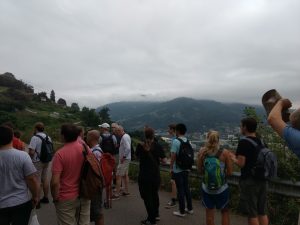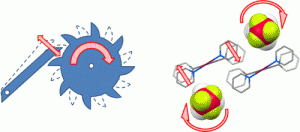
Georgia is investigating the occurence of modulation and the effects of radiation damage in a series of analogues of Barluenga’s reagent.

Georgia is investigating the occurence of modulation and the effects of radiation damage in a series of analogues of Barluenga’s reagent.
Chemical Communications 2018, 54, 9849 – 9852 [doi:10.1039/C8CC05430D]
For the collidine analogues of Barluenga’s Reagent (IPy2BF4) reported, a flat cation is necessary for the generation of a modulated phase, in keeping with the “Ratchet Model” theory [Kim et al., Crystal Growth & Design, 2014, 14, 6294]. Attempts to study “diffuse modulation” in Br(Coll)2ClO4 have shown that these non-Bragg features disappear very rapidly on exposure to synchrotron radiation, an effect thought to be caused by the radiation damage disrupting the lattice vibrations that cause the modulation.
The 31st European Crystallography Meeting was held in Oviedo, Spain from 22-26 August 2018.
 During the meeting George Sackman presented a poster (MS10-P05) on recent neutron diffraction work with Richard Cooper and Alison Edwards: Disordered or not: A cautionary tale when inferring proton disorder solely from X-ray and computational data.
During the meeting George Sackman presented a poster (MS10-P05) on recent neutron diffraction work with Richard Cooper and Alison Edwards: Disordered or not: A cautionary tale when inferring proton disorder solely from X-ray and computational data.
Richard Cooper gave a presentation (GI-MS47-O5) in the Saturday afternoon session How to… take your next steps in crystallography, based on experience of a career which despite including several areas of science and organisations rarely strayed outside the OX postcode.
On Sunday afternoon Amber Thompson presented (MS27-O5) Adventures in modulation: derivatives of Barluenga’s reagent, including work from Lewis Morgan, Yejin Kim, Emma McKinley, Jack Blandy, Claire Murray and Kirsten Christensen, in the session Quasicrystals: theory and
experiment.

Prior to the meeting, Richard Cooper was a tutor at the ECA Crystallographic Computing School in Mieres, organised by the ECA SIG 9 and gave a lecture on Programming Crystallographic Symmetry.
Crystal Growth & Design (2014). 14 (12), 6294–6301. [ doi:10.1021/cg500983s ]
 Investigations into the phase transition of Barluenga’s reagent revealed a transient incommensurately modulated phase. To understand the origin of the modulated phase and the chemistry that can affect it, analogues of Barluenga’s reagent were synthesized and studied. In this context, the halogen and anion can easily be exchanged. Studying different analogues led to the development of the Ratchet Model to describe the behavior in the solid state leading to a better understanding of modulation in this class of molecular crystal structure.
Investigations into the phase transition of Barluenga’s reagent revealed a transient incommensurately modulated phase. To understand the origin of the modulated phase and the chemistry that can affect it, analogues of Barluenga’s reagent were synthesized and studied. In this context, the halogen and anion can easily be exchanged. Studying different analogues led to the development of the Ratchet Model to describe the behavior in the solid state leading to a better understanding of modulation in this class of molecular crystal structure.
Publisher’s copy
My poster is all about Barluenga’s Reagent,
A cool iodinating and oxidising agent.
It is known to have a solid-state transition,
But we didn’t know at what temperature position.
Variable temperature X-ray diffraction
Let us investigate the transition action.
In addition, we found something a little surprising,
Extra reflections in precession images were arising.
After some thinking we came to the conclusion,
A transient modulated phase must be the solution.
So if this poem has got you excited,
Come and see my poster…
…You are all invited!
E. J. McKinley
BCA 2012.
 Emma completed her Part II in 2011 in Chem. Cryst., but it seems we can’t get rid of her! Ever cheerful, she brings a spark of life to the lab and has come back for a bit to encourage us to write up the outstanding papers from her thesis, in particular her work chalcones and on the modulated phase of Barluenga’s reagent. Since her prize winning poetry performance at the BCA, we keep expecting her to start rapping…
Emma completed her Part II in 2011 in Chem. Cryst., but it seems we can’t get rid of her! Ever cheerful, she brings a spark of life to the lab and has come back for a bit to encourage us to write up the outstanding papers from her thesis, in particular her work chalcones and on the modulated phase of Barluenga’s reagent. Since her prize winning poetry performance at the BCA, we keep expecting her to start rapping…